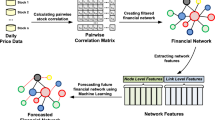Abstract
The Arbitrage Pricing Theory provides a theory to quantify risk and the reward for taking it. While the theory itself is sound from most perspectives, its empirical version is connected with several shortcomings. One extremely delicate problem arises because the set of observable asset returns rarely has a history of complete observations. Traditionally, this problem has been solved by simply excluding assets without a complete set of observations from the analysis. Unfortunately, such a methodology may be shown to (i) lead for any fixed time period to selection bias in that only the largest companies will remain and (ii) lead to an asymptotically empty set containing no observations at all. This paper discusses some possible solutions to this problem and also provides a case study containing Swedish OMX data for demonstration.
Similar content being viewed by others
References
Chamberlain G., Rothschild M. (1983) Arbitrage, factor structure, and mean-variance analysis on large asset markets. Econometrica 51(5): 1281–1304
Chen, H. (2002). Principal component analysis with missing data and outliers. Technical report, Electrical and Computer Engineering Department, Rutgers University, Piscataway, NJ.
Chen N. (1983) Some empirical tests of the theory of arbitrage pricing. The Journal of Finance 38(5): 1393–1414
Christofferson, A. (1970). The one component model with incomplete data. Ph.D. Thesis, Institute of Statistics, Uppsala University, Uppsala.
Connor G., Korajczyk R. A. (1986) Performance measurement with the arbitrage pricing theory: A new framework for analysis. Journal of Financial Economics 15(3): 373–394
Connor G., Korajczyk R. A. (1988) Risk and return in an equilibrium APT: Application of a new test methodology. Journal of Financial Economics 21(2): 255–289
Dempster A. P., Laird N. M., Rubin D. B. (1977) Maximum likelihood from incomplete data via the EM algorithm. Journal of the Royal Statistical Society, Series B (Methodological) 39(1): 1–38
Derman, E., & Kamal, M. (1997). The patterns of change in implied index volatilities. Goldman Sachs, Quantitative Strategies Research Notes.
Derman E., Kani I. (1998) Stochastic implied trees: Arbitrage pricing with stochastic term and strike structure of volatility. International Journal of Theoretical and Applied Finance 1: 61–110
Faff R. W. (1988) An empirical test of the arbitrage pricing theory on Australian stock returns, 1974-85. Accounting and Finance 28(2): 23–43
Faff R. W. (1992) A multivariate test of an equilibrium apt with time varying risk premia in the Australian equity market. Australian Journal of Management 17(2): 233–259
Gabriel K. R., Zamir S. (2008) Lower rank approximation of matrices by least squares with any choice of weights. Technometrics 21(4): 489–498
Hansen L. P., Jagannathan R. K. (1997) Assessing specification errors in stochastic discount factor models. Journal of Finance 52(2): 557–590
Lintner J. (1965) The valuation of risk assets and the selection of risky investments in stock portfolios and capital budgets. Review of Economics and Statistics 47(1): 13–37
Markowitz H. (1952) Portfolio Selection. Journal of Finance 7(1): 77–91
McElroy M. B., Burmeister E. (1988) Arbitrage pricing theory as restricted nonlinear multivariate regression model: Seemingly unrelated regression estimates. Journal of Business & Economic Statistics 6(1): 29–42
Mossin J. (1966) Equilibrium in a capital asset market. Econometrica 34(4): 768–783
Okatani T., Deguchi K. (2007) On the Wiberg algorithm for matrix factorization in the presence of missing components. International Journal of Computer Vision 72(3): 329–337
Roll R., Ross S. A. (1980) An empirical investigation of the arbitrage pricing theory. Journal of Finance 35(5): 1073–1103
Ross S. A. (1976) The arbitrage theory of capital asset pricing. Journal of Economic Theory 13(3): 341–360
Ruhe, A. (1974). Numerical computation of principal components when several observations are missing. Technical report, UMINF-48-74, Department Information Processing, Umeå University, Umeå.
Rydberg T. H. (2000) Realistic statistical modelling of financial data. International Statistical Review 68(3): 233–258
Schott J. R. (2005) Matrix analysis for statistics (2nd ed.). Wiley-Interscience, New York
Sharpe W. F. (1964) Capital asset prices: A theory of market equilibrium under conditions of risk. Journal of Finance 19(3): 425–442
Shukla R., Trzcinka C. (1990) Sequential tests of the arbitrage pricing theory: A comparison of principal components and maximum likelihood factors. Journal of Finance 45(5): 1541–1564
ten Berge J. M. F. (1993) Least squares optimization in multivariate analysis. DSWO Press, Leiden The Nederlands
Wiberg, T. (1976). Computation of principal components when data are missing. In Proceedings of second symposium computational statistics, pp. 229–236.
Wold H., Lyttkens E. (1969) Nonlinear iterative partial least squares (NIPALS) estimation procedures. Bulletin of the International Statistical Institute 43: 29–51
Author information
Authors and Affiliations
Corresponding author
Rights and permissions
About this article
Cite this article
Karlsson, P.S. The Incompleteness Problem of the APT Model. Comput Econ 38, 129–151 (2011). https://doi.org/10.1007/s10614-011-9255-1
Accepted:
Published:
Issue Date:
DOI: https://doi.org/10.1007/s10614-011-9255-1




